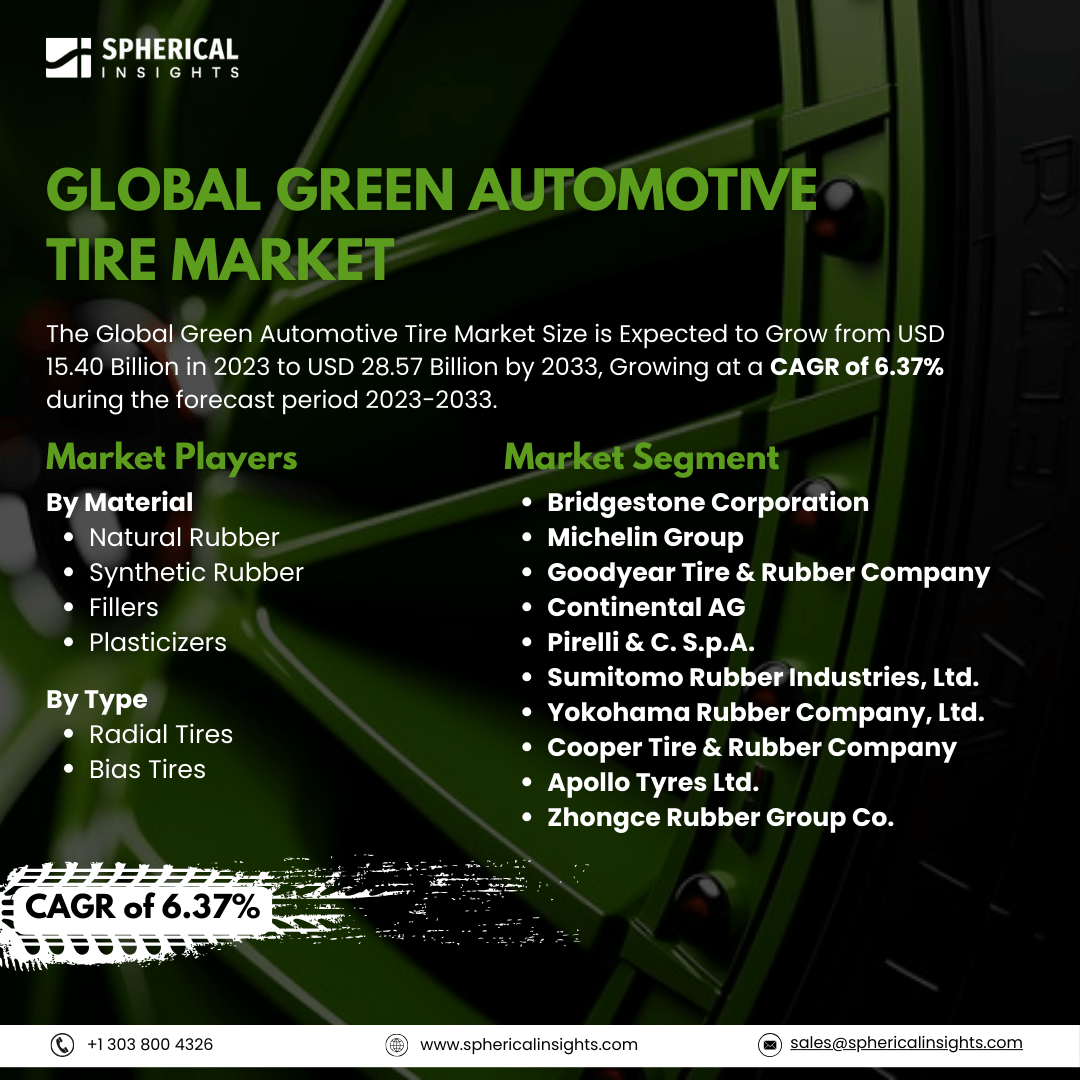Global Green Automotive Tire Market Size To Exceed USD 28.57 Billion By 2033
According to a research report published by Spherical Insights & Consulting, The Global Green Automotive Tire Market Size is Expected to Grow from USD 15.40 Billion in 2023 to USD 28.57 Billion by 2033, Growing at a CAGR of 6.37% during the forecast period 2023-2033.
Browse 210 market data Tables and 45 Figures spread through 190 Pages and in-depth TOC on the Global Green Automotive Tire Market Size, Share, and COVID-19 Impact Analysis, By Type (Radial Tires, Bias Tires), By Material (Natural Rubber, Synthetic Rubber, Fillers, Plasticizers, and Others), By Distribution Channel (OEM, Aftermarket), and By Region (North America, Europe, Asia-Pacific, Latin America, Middle East, And Africa), Analysis And Forecast 2023 – 2033.
The international green automotive tire market refers to the business concerned with the fabrication, sales, and delivery of automotive tires, which are mainly made for sustainable purposes. These tires are made using eco-friendly materials, like natural rubber, silica, and recycled components, and this helps improve fuel efficiency and lower carbon emissions. The market expansion is driven by increasing environmental awareness, government regulations, and advancements in tire technology. Further, the government incentives encourage market expansion. Moreover, the collaborative projects between key market players which boosting the expansion of the market. However, the market growth faces several obstacles, like economic uncertainty, high upfront costs, and strict regulatory laws.
The bias tires segment held a significant share of the global green automotive tire market in 2023 and is anticipated to grow at a rapid pace over the forecast period.
On the basis of the type, the global green automotive tire market is differentiated into radial tires, bias tires. Among these, the bias tires segment held a significant share of the global green automotive tire market in 2023 and is anticipated to grow at a rapid pace over the forecast period. This is because of their resilience to harsh terrain and large weights, and they are frequently seen in off-road applications and heavy-duty vehicles, along with their affordability and durability.
The natural rubber segment held the highest share of the global green automotive tire market in 2023 and is anticipated to grow at a notable CAGR over the forecast period.
On the basis of the material, the global green automotive tire market is differentiated into natural rubber, synthetic rubber, fillers, plasticizers, and others. Among these, the natural rubber segment held the highest share of the global green automotive tire market in 2023 and is anticipated to grow at a notable CAGR over the forecast period. This is because of their superior flexibility, resilience against deterioration, and environmentally beneficial qualities.
The OEM segment accounted for the largest share of the global green automotive tire market in 2023 and is anticipated to grow at a significant CAGR over the forecast period.
On the basis of the sales channel, the global green automotive tire market is segmented into OEM and aftermarket. Among these, the OEM segment accounted for the largest share of the global green automotive tire market in 2023 and is anticipated to grow at a significant CAGR over the forecast period. This is due to the need for guaranteed adherence to safety regulations and performance specifications. Moreover, the adoption of sophisticated technology accelerates the segment growth.
Asia is projected to hold the largest share of the global green automotive tire market over the forecast period.
Asia is expected to hold the greatest share of the global green automotive tire market over the forecast period. The regional market is propelling due to the presence of significant automakers, rising vehicle production, and government policies encouraging environmentally friendly technologies. The adoption of green tires in the area is being driven by the growing middle class, fast urbanization, rising disposable incomes, and increasing demand for low-emission and fuel-efficient automobiles.
North America is anticipated to grow at the fastest CAGR of the global green automotive tire market over the forecast period. The market expansion throughout the region is further driven by strict emission regulations and consumer awareness of sustainability. Moreover, the United States and Canada are leading the regional market expansion, with a strong automotive industry and their related services. Additionally, factors such as the presence of major key manufacturers, sophisticated techniques with R&D facilities, and robust distribution networks drive the market growth.
Company Profiling
Major vendors in the global green automotive tire market are Bridgestone Corporation, Michelin Group, Goodyear Tire & Rubber Company, Continental AG, Pirelli & C. S.p.A., Sumitomo Rubber Industries, Ltd., Yokohama Rubber Company, Ltd., Cooper Tire & Rubber Company, Apollo Tyres Ltd., Zhongce Rubber Group Co., and others.
Key Target Audience
- Market Players
- Investors
- End-users
- Government Authorities
- Consulting And Research Firm
- Venture capitalists
- Value-Added Resellers (VARs)
Recent Development
- In November 2022, GRI unveiled the Green XLR Earth 65+, a radial agriculture tire designed with sustainability and performance in mind. This innovative tire incorporates 37.5% sustainable materials, including natural rubber, recycled carbon black, and soybean oil, replacing petroleum-based components.
Market Segment
This study forecasts revenue at global, regional, and country levels from 2023 to 2033. Spherical Insights has segmented the global green automotive tire market based on the below-mentioned segments:
Global Green Automotive Tire Market, By Type
Global Green Automotive Tire Market, By Material
- Natural Rubber
- Synthetic Rubber
- Fillers
- Plasticizers
- Others
Global Green Automotive Tire Market, By Distribution Channel
Global Green Automotive Tire Market, By Regional
- North America
- Europe
- Germany
- UK
- France
- Italy
- Spain
- Russia
- Rest of Europe
- Asia Pacific
- China
- Japan
- India
- South Korea
- Australia
- Rest of Asia Pacific
- South America
- Brazil
- Argentina
- Rest of South America
- Middle East & Africa
- UAE
- Saudi Arabia
- Qatar
- South Africa
- Rest of the Middle East & Africa



